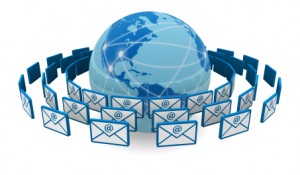For years, rumors have circulated that email marketing is dying and teenagers the world over have proclaimed email as, “something old people do”. 
Whether you agree or disagree that email has one foot in the grave, many online marketers are finding effective ways to leverage email as part of a social media marketing mix. Integrating email and social media was the topic of discussion at a session during the MIMA Summit last week with Loren McDonald, VP of Industry Releations, SilverPop and Brian Brown, Director of Modern Marketing, ideapark.
Social sharing options embedded in online content have helped increase distribution and reach for thousands of web sites. One of the most common ways email has been used in a social context is “Forward to a Friend”. However, the tried and true ‘Forward to a Friend’ link has less than .1% CTR, so many marketers have taken it upon themselves to find a new way to circulate content amongst networks.
Alternatively, there is the ‘Share to Social’ (S2S) link. While S2S is relatively new, a .5% CTR gives early reason to be optimistic according to a Silverpop study.
The Silverpop Share-to-Social study also reported that S2S is likely to result in sharing of content with 150 to 200 people on average. In contrast, a “forward to a friend” link may reach an additional 1 to 2 people. Share to social use results in a 24% increase in reach on average.
How does Share-To-Social (S2S) Work? S2S is a call to action such as ‘Share this Newsletter’ followed by graphical links to various social network or content sharing sites such as Facebook, LinkedIn, Twitter, StumbleUpon and so forth. all within the email message.
If you look at most blogs and online publishers, social sharing buttons are not anything new. In fact, TopRank created one of the first tools for blogs to embed social bookmarking buttons over 3 years ago. Posting them within email messages, however, is catching on and there are a few guidelines to follow for successful integration:
Understand what motivates subscribers to share
People share for different reasons including:
- Self Interest: People share because they think they will be rewarded. i.e. sweepstakes
- Altruism: sharing makes them feel good
- Validation: sharing feeds the ego
- Affinity: sharing makes people feel more a part of the community
- Prurience: sharing makes people feel less guilty for gawking
Target the right social networks and media
Is the use of 4 or 5 networks the right number? If not, how many is?
Be sure to do your homework and identify on which social sites your target audience is spending time. Of those, on which sites are they interacting or sharing content the most?
Once you have this identified, don’t shut down the research. Continue to follow the target audiences to make sure they aren’t migrating to a new site leaving you unaware.
Keys to targeting the right networks:
- Utilize 3rd party research
- Survey subscribers/monitor network activity
- Test and analyze click/share activity
- Identify subtrends i.e. high value sharers
- Kill the losers
Educate subscribers on how/why to share
Despite the growth, ‘sharing’ is still early among some audiences.
Alongside the ‘share this’ buttons, consider adding a ‘what’s this’ button and give them instructions on how and why to use the feature.
Encourage people to share. Placing the links on the page/email may not be enough. Just like with anything marketing, you need to include call to actions to get people interacting.
Once you have integrated S2S, the next step is to identify high value sharers. Who are the ‘few’ people that often share your content and have a larger than average network?
Optimize email sharing design and link location
Where to put the links?
Test different placement of the ‘share this’ links. Top, Middle, Bottom, Sidebar etc.
At the very least, by moving it around you can avoid users getting used to seeing it and therefore ignoring it.
Eight ways to create shareworthy content:
- Trustworthy – Brand and source of content or offer is widely known and trusted
- Tap into Tribes – Message content speaks to tribal groups within subscriber base
- Obvious – Essence of the email content to be shared is obvious, simple to grasp
- Easy to Share – Sharing links are easy to find and use
- Social Acumen – Targets the right social networks and social acumen of subscribers
- Creates Value – Must provide value or recipients will not share
- Rewards/Incentives
- Great Content
What B2B emails are shareworthy? Articles and statistics.
What’s not shareworthy? Long newsletters, negative news and highly personalized emails.
Analyze, test and refine for increased sharing
Test – what’s working and what’s not including:
- Copy
- Link style
- Link location
- Broad vs narrow focus messages
- Viral-only messages
- High-value sharers
Key Takeaways for integrating social networks and email:
- Narrow your network focus
- Make it easy to share
- Determine what your subscribers find most ‘shareworthy’
- Identify and reward your key influencers
- Test everything and don’t be afraid to fail
At our agency TopRank, we’ve been implementing email marketing programs in conjunction with other online marketing and lead generation efforts including social media for 5 years. A good starting point to improving email effectiveness is to read some of the better email marketing tactics online and this recent post from WebProNews on why social media isn’t replacing email.
Are you implementing email marketing with social networking? (outside of the emails that occur within the social network) What have you found to be the best/worst practices?


